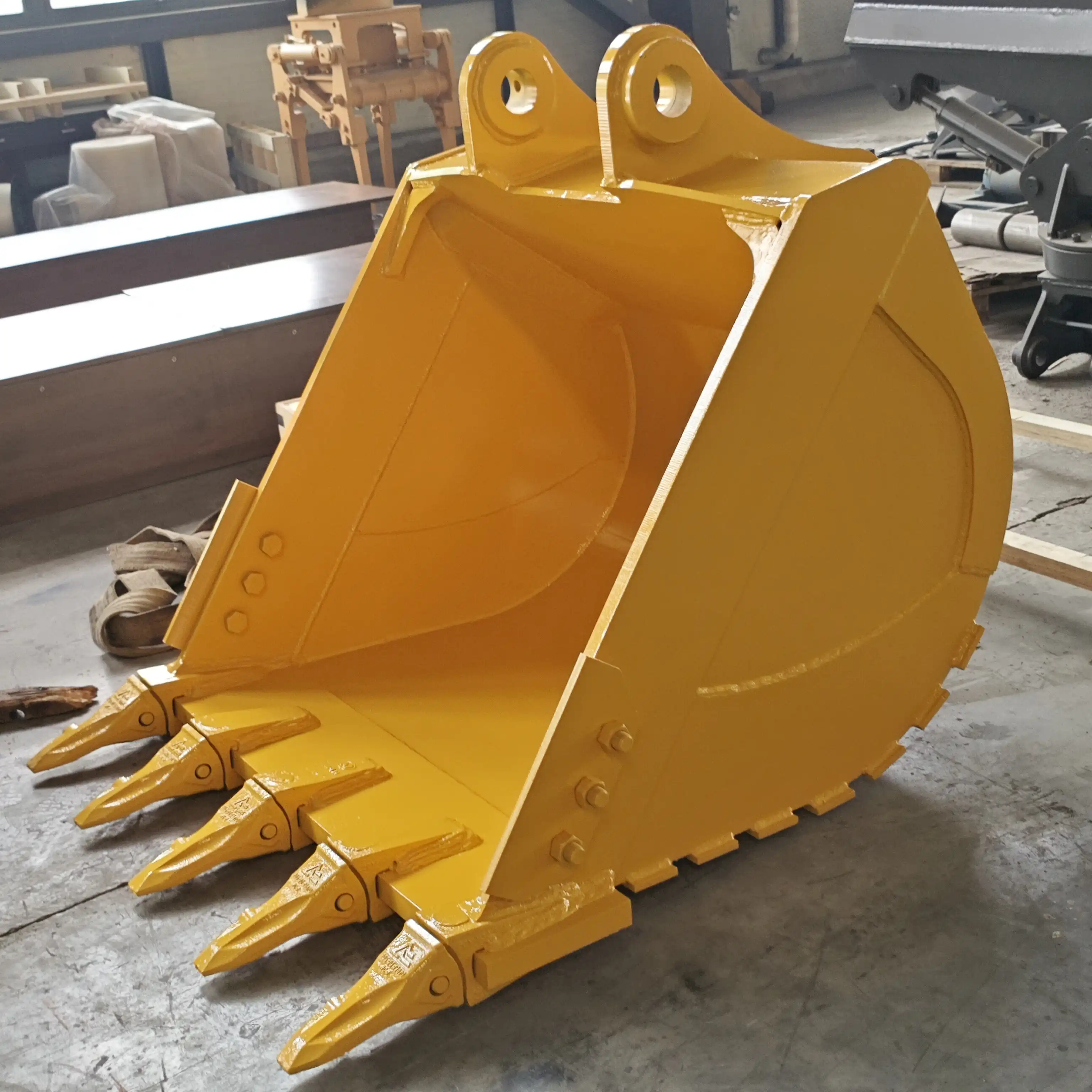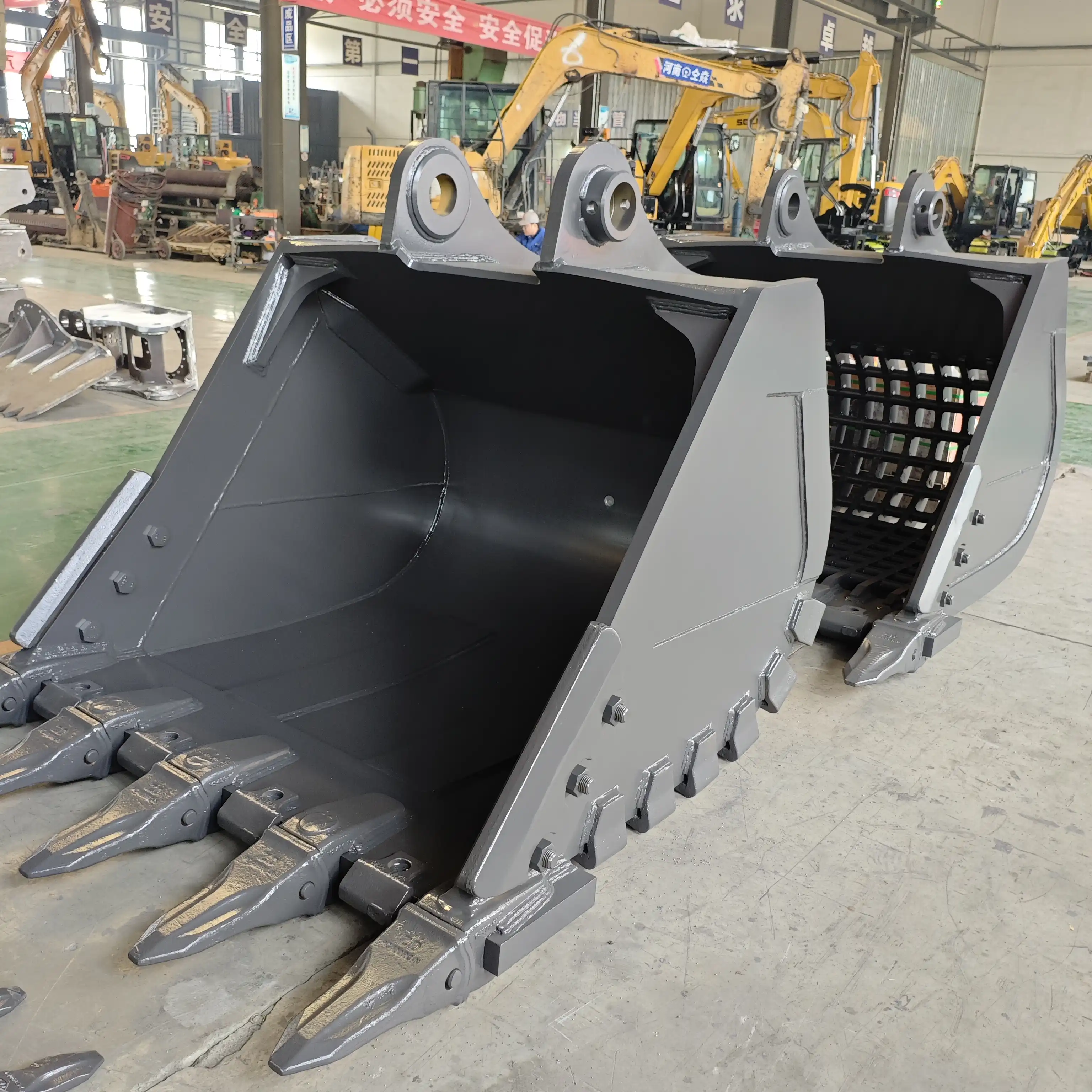How much does a bucket on an excavator weigh?
When planning construction projects or considering equipment upgrades, one question that frequently arises is about the weight of excavator buckets. The weight of a bucket typically ranges from 100 kg to 2,000 kg (220 to 4,400 pounds), depending on several factors, including bucket size, material construction, and application purpose. General-purpose buckets for 20-ton excavators usually weigh between 800-1,000 kg, while smaller machines may use buckets weighing 200-300 kg. Heavy-duty rock buckets designed for challenging conditions can weigh significantly more, sometimes exceeding 1,500 kg for larger excavator models.
Understanding bucket weight is crucial because it directly impacts excavator performance, fuel efficiency, and operational capabilities. An improperly matched bucket can strain hydraulic systems, reduce stability, and potentially damage the excavator arm. Additionally, transportation logistics and site mobility are affected by the combined weight of the machine and its attachments. Professional operators recognize that selecting the right bucket weight balance for specific applications can significantly improve productivity while minimizing wear on equipment components.
A properly sized bucket enhances digging efficiency, maintains proper counterbalance, and ensures the excavator operates within its designed lifting capacity. Many contractors find that investing in multiple bucket options with varying weights provides versatility across different job requirements and ground conditions.
General Purpose Buckets

Weight Range and Specifications
General-purpose excavator buckets are designed for everyday digging operations in relatively consistent soil conditions. These versatile attachments typically weigh between 100-1,000 kg, depending on the size of the excavator they're paired with. For mini excavators (1.5-6 tons), general-purpose buckets usually weigh 100-300 kg. Medium-sized excavators (7-25 tons) utilize buckets weighing approximately 300-800 kg, while larger machines may use buckets approaching 1,000 kg.
The capacity of these buckets ranges from 0.1 to 2.0 cubic meters, with width variations from 500 mm to 1,500 mm. Most general-purpose buckets are manufactured from steel with moderate wear resistance, providing a balance between durability and weight. These buckets typically feature a standard tooth configuration with replaceable teeth and adapters.
Applications and Durability
General-purpose buckets excel in landscaping, trench digging, and light material handling. Their balanced design makes them suitable for a wide range of soil types, excluding extremely hard or rocky conditions. Under normal usage, these buckets typically last 2-3 years before requiring significant maintenance or replacement.
The moderate weight of general-purpose buckets enables operators to maintain excellent fuel efficiency while achieving respectable digging speeds. Many contractors appreciate how these buckets provide sufficient capacity without overtaxing the hydraulic systems of their machines, making them ideal for residential construction, utility installation, and routine earthmoving applications.
Maintenance Requirements
General-purpose buckets require relatively straightforward maintenance compared to their heavy-duty counterparts. Regular inspection of teeth, cutting edges, and wear plates is essential to maintain optimal performance. Replacement teeth typically need changing every 200-300 operating hours, depending on soil conditions and usage intensity.
The weight distribution of general-purpose buckets creates less stress on pivot points and bushings, potentially extending the lifespan of these components. This weight advantage translates to lower long-term maintenance costs and improved operational efficiency for everyday digging tasks.
Heavy-Duty Buckets

Material Composition and Weight Characteristics
Heavy-duty excavator bucket attachments are specifically engineered for challenging environments and demanding applications. These robust attachments typically weigh 30-50% more than their general-purpose counterparts, with weight ranges from 300 kg for smaller models to over 2,000 kg for large excavator applications. The substantial weight increase stems from several design features:
Heavy-duty buckets incorporate thicker base materials, often utilizing high-carbon steel plates up to 30-40% thicker than standard buckets. Additional reinforcement plates are strategically positioned along high-stress areas, particularly at the connection points with the excavator arm. The cutting edge thickness typically measures 50-80 mm compared to the 30-40 mm found on general-purpose models. Many heavy-duty buckets also feature enhanced wear protection through the application of hardened steel overlays or replaceable wear strips.
The side cutters and tooth adaptors on heavy-duty buckets incorporate additional material to withstand extreme abrasion and impact forces. Some specialized rock buckets even utilize premium wear-resistant alloys that significantly contribute to the overall weight while extending service life in punishing conditions.
Performance in Challenging Conditions
The increased weight of heavy-duty buckets provides notable advantages in demanding applications. The substantial mass creates greater penetrating force when excavating compacted material, allowing operators to maintain productivity in conditions where lighter buckets would struggle. Heavy-duty buckets excel in rock excavation, demolition work, and mining operations where material density and hardness present significant challenges.
The weight distribution across heavy-duty buckets helps maintain stability during aggressive digging cycles, reducing bouncing and improving precision when working with challenging materials. This stability proves particularly valuable when breaking through hard surfaces or extracting densely packed soil with embedded rocks.
Compatibility and Equipment Considerations
Heavy-duty bucket weight significantly influences excavator performance and requires careful matching with appropriate machinery. Pairing these substantial attachments with undersized excavators can lead to reduced lifting capacity, slower cycle times, and potential damage to boom structures and hydraulic systems. Manufacturers typically recommend using heavy-duty buckets only with excavators meeting specific weight class requirements.
Equipment modifications may be necessary when consistently using heavy-duty buckets, including hydraulic system adjustments, counterweight additions, or undercarriage reinforcements. Some operators report fuel consumption increases of 10-15% when using heavy-duty buckets compared to general-purpose alternatives, reflecting the additional power required to manipulate these heavier attachments.
Despite these considerations, the durability and capability advantages of heavy-duty buckets make them essential tools for professionals working in severe conditions, where bucket longevity and consistent performance justify the weight-related compromises.
Factors Affecting Bucket Weight

Bucket Size and Capacity
The size and capacity of an excavator bucket serve as primary determinants of its weight. Larger buckets necessarily incorporate more material in their construction, resulting in proportionally higher weights. Bucket capacity measurements typically range from 0.1 cubic meters for mini excavators to 5.0 cubic meters for large mining excavators, with corresponding weight variations from approximately 100 kg to 2,000 kg.
Volume increases exponentially relative to dimensional changes, creating a non-linear relationship between bucket size and weight. For instance, increasing bucket width by 25% typically results in weight gains exceeding 30% due to the corresponding increases in base material, side plates, and reinforcement requirements. Manufacturers often provide detailed weight specifications across their product lines, allowing contractors to precisely match bucket capacity to equipment capabilities.
The relationship between bucket size and material density also influences weight considerations. Buckets designed for handling lighter materials like coal or clay can utilize thinner materials than those intended for rock or demolition work, even when offering similar volumetric capacity.
Material Construction and Reinforcement
Construction materials significantly impact bucket weight, with steel quality and thickness serving as critical variables. Standard buckets typically utilize mild steel with tensile strengths around 400-500 MPa, while premium options incorporate high-strength wear-resistant steels exceeding 700 MPa. Higher-strength materials allow for weight reduction without compromising durability, though such buckets generally command premium prices.
Reinforcement design philosophies vary among manufacturers, with some focusing on strategic placement of thickened sections while others employ overlay techniques. Modern bucket designs increasingly utilize finite element analysis to optimize weight distribution, allowing for targeted reinforcement only where structurally necessary. This approach minimizes unnecessary weight while maintaining strength in critical areas.
The attachment mechanism also influences weight significantly. Quick-coupler compatible buckets typically weigh 15-25% more than direct-pin alternatives due to the additional material required for coupler interfaces. Some buckets incorporate hardened wear strips or replaceable wear packages that can add 50-100 kg to the total weight but substantially extend service life in abrasive conditions.
Specialized Features and Add-ons
Many excavator buckets include specialized features that increase functionality while adding weight. Thumb attachments for handling irregular materials can add 100-200 kg to the bucket assembly. Hydraulic rotating buckets, which offer enhanced positioning capabilities, typically weigh 30-40% more than fixed models of similar capacity due to the integrated rotation mechanisms.
Protective features such as rock guards, side cutters, and wear plates incrementally increase bucket weight. Collectively, these optional components can add 50-150 kg, depending on their design and coverage area. Some specialized buckets incorporate serrated edges or ripping capabilities for breaking through hard surfaces, requiring additional reinforcement that further increases weight.
Tooth systems represent another variable affecting overall weight. Standard teeth typically add 5-15 kg each, while heavy-penetration tooth designs for extremely hard materials can weigh substantially more. Buckets configured with maximum tooth count for specialized applications may carry an additional 50-100 kg compared to standard tooth arrangements.
FAQ

①What is the average weight of a standard excavator bucket?
Standard buckets typically weigh between 100-1,000 kg, with the exact weight depending on the size of the excavator. Mini excavator buckets usually weigh 100-300 kg, medium excavator buckets range from 300-800 kg, and large buckets can weigh up to 2,000 kg or more.
②How does bucket weight affect excavator performance?
Bucket weight directly impacts excavator balance, fuel efficiency, and lifting capacity. Heavier buckets reduce the effective reach and lifting capability of the machine but may provide better penetration force in tough materials. Properly matched bucket weight ensures optimal performance and prevents premature wear on boom components and hydraulic systems.
③Are lightweight buckets available for specialized applications?
Yes, specialty lightweight buckets constructed from high-strength steel alloys can reduce weight by 15-25% compared to standard models. These buckets maintain strength while improving fuel efficiency and increasing effective reach, though they typically cost more and may have reduced wear resistance in abrasive conditions.
④How often should excavator buckets be replaced?
Bucket replacement intervals vary widely based on application intensity and material conditions. General-purpose buckets typically last 2-4 years under normal conditions, while heavy-duty buckets may provide 4-7 years of service in similar environments. Buckets used in extremely abrasive conditions like quarrying might require replacement within 1-2 years despite their reinforced construction.
⑤Can I use a bucket from one manufacturer on a different brand of excavator?
Many aftermarket buckets are designed with universal compatibility, though performance may vary from OEM specifications. When using non-OEM buckets, ensure the attachment points match precisely and verify that the bucket weight falls within the recommended range for your specific excavator model. Quick coupler systems can facilitate interchange between different bucket types and brands.
Selecting the right excavator bucket weight is crucial for both performance optimization and equipment longevity. Understanding these weight considerations helps contractors make informed decisions when purchasing or renting equipment for specific applications. For professional guidance on selecting the appropriate bucket for your operational needs, reach out to the Tiannuo team of experts at boom@stnd-machinery.com.
References
Construction Equipment Guide. "Excavator Bucket Selection: Matching Weight to Performance" (2024)
Journal of Construction Engineering. "Impact of Attachment Weight on Hydraulic Excavator Efficiency" (2023)
Heavy Equipment Technical Manual. "Standard Weight Specifications for Excavation Attachments" (2023)
International Association of Equipment Manufacturers. "Weight Classification Standards for Earthmoving Attachments" (2024)
Machinery Operation Quarterly. "Optimizing Excavator Performance Through Appropriate Bucket Selection" (2024)
About Author: Arm
Arm is a leading expert in the field of specialized construction and railway maintenance equipment, working at Tiannuo Company.

